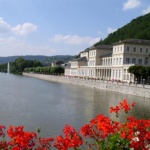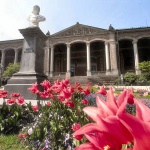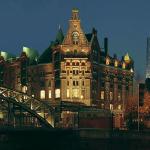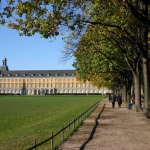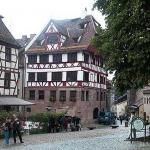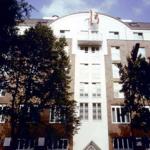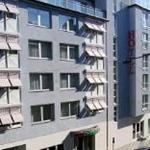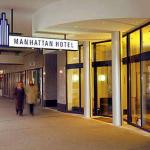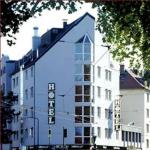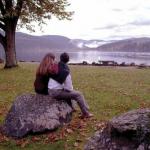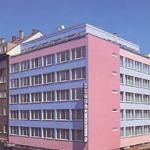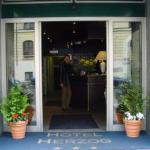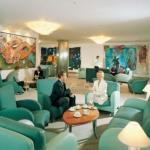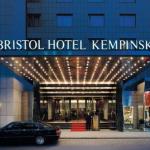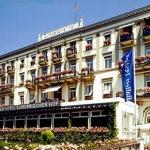Germany Sights
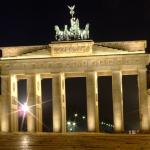 Germany attracts tourists the picturesque valley of the Rhine with a lot of medieval castles and monasteries, ancient culture of Bavaria, the picturesque Black Forest, calm Baltic coast and many historic monuments. South of the country is famous for its clean lakes and mountain resorts of the foothills of the Alps, as well as its wine-making, the main points of which are also located in the southern areas along river valleys.
Germany attracts tourists the picturesque valley of the Rhine with a lot of medieval castles and monasteries, ancient culture of Bavaria, the picturesque Black Forest, calm Baltic coast and many historic monuments. South of the country is famous for its clean lakes and mountain resorts of the foothills of the Alps, as well as its wine-making, the main points of which are also located in the southern areas along river valleys.Berlin - capital of the revived, united Germany, is situated at the confluence of the rivers Spree and Havel in the geographical center of the country. The first settlements on the territory of modern Berlin appeared about 10 thousand years ago, around the year 700 BC. e. old Germanic tribes settled here and in VI-VII centuries. Mr. e. West Slavic tribes appeared, which gave the modern name of the city ( "Berlin" - a fishing village, ferry). In 1244 Berlin had already mentioned in the chronicles as the city. List all the attractions of the capital is very difficult - all the historical center, in essence, is a collection of historical, cultural and architectural monuments, however, severely damaged during the bombing and the assault on Berlin in 1945
Hallmark of the city are magnificent Brandenburgckie Gates (1788-1791 gg.) From the checkpoint Charlie "- a symbol of the Cold War (now converted into a museum), the west wall which saved the area notorious" Berlin Wall " dividing the city during the "great confrontation". The length of the wall was about 155 km. (43.1 km. Comes directly to the city), and the height reached 4.1 m. Equipped with 293 watchtowers, 57 bunkers and Pillbox infiltrated by many hundreds of miles of barbed wire and bounded by 100-meter strip of alienation, the wall has become a symbol of the division of Germany and was literally swept away by protesters at uniting the country, and its fragments turned into souvenirs.
Very attractive miraculously survived the fires of the Second World War, the Cathedral of St. Hedwig (1747-1773 gg.), The Arsenal (1695-1706 gg.) Cathedral of St. Nicholas in the Gothic style (XIV cent.), The largest in the world, Berlin Zoo, Tsoyghauza building (now here is the German Historical Museum), the Gothic church Marienkirche and others again were virtually rebuilt such famous monuments of the city, as the German State Opera, the Reichstag (1884-1894 gg.) street Unter den Linden, the Bellevue Castle (1785 .), Kaiser-Wilhelm-Kirche, Castle Sharlottenberg (XVII-XVIII cc.), and whole blocks of classic buildings of XVIII-XIX centuries. Many new facilities have given the city a unique modern look - the Berlin TV Tower (365 m), famous for its extensive collection of botanical garden, a complex of monuments to Soviet soldiers who died - Treptow Park, Hanzafirtel, Theater des Vestens, City Library, International Congress Center, Philharmonic Hall, Europa-Center, Berlin Green Estrada and others are also interested in the majestic palace Fridrihshtadtpalas, Shenebergskaya Town Hall, Alexanderplatz, the famous Red Town Hall, Fountain of Neptune, Hall Kongresshalle area ERHRs, Reuters, New Synagogue, the area Braytshaydplatts, gloomy headquarters building a secret police of the GDR - the Stasi, watch "Globe", the Church of Remembrance, etc.
Concentrated in the city are many excellent museums and art collections, most of which has a long history - Museum Foundation of Prussian Castles, Art Gallery in Dahlem with a large collection of paintings by old masters, sculptures, Indian, Oriental and Islamic art, which he started to collect more Friedrih the Great, Egypt Museum, Arts Gallery. Bode on one of the most extensive and diverse collections of European painting period XIII-XVIII century., Kulturforum, New National Gallery and the Museum Island in the district. Spree with museums and the Pergamon-Stiftung Proysisher Kulturbezitts etc.
One of the most beautiful places around the city - Potsdam, the former with the XVII century. residence of Prussian kings. This magnificent architectural complex of baroque and classicism is situated on the river Havel and the famous Schloss Sanssouci beautiful palaces and mansions of Wilhelm II, which in July 1945 passed the famous Potsdam Conference.
Bremen (included with the city of Bremerhaven in Bremen federal land as a separate city) lies on the banks of the River. Weser and is known as one of the oldest cities in the country. Center Bremen is an old market square with town hall (1405-1410 gg.) And St. Peter's Cathedral (XI century.), Here-as is the building of the city parliament (1966), built to replace the destroyed before the foundation of Anglo-American bombing of the old parliament and miraculously preserved medieval burgher houses and a symbol of the city - a 10-meter statue of Roland (1405). Before the City Hall (1405-1410 gg., Rebuilt in 1608-1612 gg.) Is a famous sculptural group "The Bremen Town Musicians". The most famous street in Bremen - Betthershtrasse, has a length of 100 m and consists of only 7 buildings built in the XVII., Which in themselves are unique monuments of architecture, they settled zvonarnitsa, three museums, galleries and a theater. Tourist attractions are also a velichesvenny Bremen Bremen Cathedral (XI-XIII cc.) And the old street Shnervirtel.
"Free City of Hamburg lies on the banks of the River. Elba is 110 kilometers. from the place of its confluence with the Baltic Sea. This is the largest sea and the fourth largest river port in Germany, one of the best anchorages in the Baltic Sea and the large yacht center of the country. Probably no other city in Europe has so many closed streets and passages, which start directly from the trade center - the Hamburg court. The whole of Europe famous passage, "Hansevirtel", "Gergof", "Gansemarkt" and "Neue Gansemarkt. Hamburg is one of the richest cities in the country, there are offices of many trading firms, banks and insurance companies. Most of the old buildings of the city destroyed during the war, but was a symbol of "Michel" - 132-meter high tower of the church of St. Michael, almost not affected and has been carefully restored.
Bavaria - the largest and most visited tourist regions of Germany. With its cultural diversity, a rich historical past and the peculiar geographical position, Bavaria is considered one of the best tourist areas, not only Germany but across Europe. This area is famous for the diversity of its nature - it is here that extends the famous Bavarian Alps, is the set of the most picturesque lakes (Chiemsee, Starnberg, Ammersee and the western part of Lake Constance), extensive alpine pastures, forests and numerous rivers. Here is a unique National Park "Bavarian Forest".
Munich, the third largest city in Germany, located near the Alps on the banks of the Isar. Center city is Marienplatz with the buildings of the new (XIX cent.) And old (in 1470, today houses the Museum of Toys) Town Hall. Near Marienplatz are such famous monuments of the city as the church Peterskirhe (XI cent.), A picturesque ensemble of natural English gardens, the pedestrian zone and main shopping-street of the city - Neuhauser Strasse, a street Tal area of Justice and the old botanical garden. The main cathedral of the city and its symbol is the Frauenkirche (Libfrauenkirhe). The south of the complex of royal residences (XVI-XIX cc.) Situated Bavarian National Theater (Bavarian National Opera, 1811-1818 gg.) Yuzhnogermanskaya and the first church in the baroque style - Teatinerkirhe. Another attraction - the most famous and oldest beer hall of Munich - Hofbräuhaus (XII cent.), Located in the heart of the city, in the town Plattsl. It was here in 1923 there was a "Beer Hall Putsch, which became the beginning of Hitler's political career.
Every autumn (late September - early October) in the meadow goes Theresienwiese most popular annual festival of the World - Beer Festival "Oktoberfest" takes place almost two hundred years, for whom even a special brew beer - Wizna.
The city is famous for its art galleries worldwide - here are Old and New Pinakothek - one of the best art galleries of Europe, the Bavarian National Museum, Munich City Museum, the state Mineralogical and numismatic collections, German Theater Museum and the National Gallery Lenbach. Be sure to visit the unique Museum of BMW.
Nuremberg, the second largest city of Bavaria, is located in the rich forests in the region pp. Pegnitz. The most beautiful view of the old city gate opens with Fyursterskih - ring of walls Shtadtmauera (XIV-XV cc.) With a lot of gates and towers, the "old town" of Lorenz and the castle. Old town's mark "King's Gate" ( "Kenigstor") with a huge observation tower from which the leaves, the oldest street in town - Königstraße, which are the Church of St. Martha, Deutsches National Museum (the largest museum of art, culture and history of all Germanic countries, was founded in 1852) and the Church of St. Lorenz - the largest church in Nuremberg (XIII-XV cc.). Not far from the bridge area is Muzeumbreshke Hauptmarkt, with 17-meter sculpture Schoene Brunnen, church Froyenkirhe (1352-1361 gg.) And the famous clock "Maenleynlaufen" (1509), City Hall (1616-1622 gg.) And the church of St. Sebaldusa (1225-1273 gg.). Be sure to visit the Nuremberg Toy Museum with toys for all ages and different cultures, the Nuremberg castle and museum-house of Albrecht Durer, in which he lived from 1509 until the last day of his life (1528).
Be sure to visit the famous Bavarian Baroque ensembles, located in the picturesque corners of the province. The most famous of them - the former summer residence of Bavarian kings - Castle Nymphenburg, "fabulous" Neuschwanstein Castle near the Austrian border, a medieval fortress castle Hohenschwangau, the castle-palace Linderhof (1869-1879 gg.) With a spectacular park, Moorish Pavilion and the Temple of Venus and the Herrenchiemsee.
Saxony - the land in the foothills of the Ore Mountains in the south-east of the country. The beauty of the landscape, bizarre forms of relief, cultivated forests and dozens of picturesque old towns in this region attract thousands of tourists.
Dresden (the first record - 1206) - the capital of Saxony and the pearl. "Florence on the Elbe, Dresden was called before the Second World War. As a result of the Anglo-American bombing during the night from 13 to 14 February 1945, Dresden was practically wiped out, but today he gradually regains the glory of the world's cultural center. It is situated on the banks of the Elbe River city monument boasts many architectural masterpieces, there are such unique structures as the church in style rokkoko Hofkirchen (1739-1751 gg.), The world-famous masterpiece of Baroque art - the Zwinger Palace complex (1710-1722 gg.) Palace Bridge, Chapel Castle Torgau, Albertinum, Academy of Fine Arts, School of Art and the Gothic Kreitskirhe (XV cent.).
Opened in 1854, Dresden Gallery, whose treasures happily escaped the horrors of bombings in rocky galleries in the nearby mountains, gained famed as one of the richest collections in the world. Restored from the ruins and built in the style of Italian Renaissance Opera House (1870-1878 gg.). 15 km. of Dresden is famous Meissen manufactory - Homeland highest European white porcelain. In the open to the public showroom the company billed more than 4 thousand exhibits, telling about the history of this famous brand. You can make any kind of excursions into the surrounding Ore Mountains have received for its picturesque landscapes of the name "Saxon Switzerland".
Leipzig - the biggest city in Saxony, the city of fairs, the biggest center of publishing and commerce. Thousands of tourists attracted by the Citadel (XIII century.) Tomaskirhe famous church (Church of St. Thomas, XIV-XV cc.), A giant monument Folkersshlahtdenkmal ( "Battle of the Nations, 1898-1913 gg.), Erected in honor of soldiers (including and 22,6 thousand Russian soldiers) who died in battle with the army of Napoleon at Leipzig in 1813, the oldest and largest church of the city - Nikolaikirche (St. Nicholas), restored the city center with its famous shopping arcades and Medler Shpekks Hoof, Orthodox Church in memory of the dead Russian soldiers (XIX century), the world-famous art gallery, the old Town Hall and the zoo.
Lower Saxony, which occupies the north-western part of the country - one of the main tourism centers of the country. Here, on the North Sea coast, there are many natural parks, large tracts of wasteland and marshes, picturesque East Frisian Islands and the South - the beautiful landscapes Vezergebirge, Osnabryukker Bergland, Lappvalda, Deystera, Zyuntelya, Ith, Hills and Zollinga.
The capital of Lower Saxony is the ancient Hanover ( "city on the bank"), first mentioned in chronicles in 1150 - a city of international exhibitions, parks and the original architecture. Hanover also suffered terrible destruction during the Second World War, but quickly regained its former greatness. The most interesting sights are the magnificent Baroque garden in Herrenhauzen (1666-1714 gg.), Whose majestic castle was destroyed bomardirovkami, but kept a greenhouse and gallery, as well as the Waterloo column (46 m high, 1832), an artificial lake Mash, Central Station Gauptbanhof, Opera Theater, a beautiful main square of the city - Strong, which is a famous "Rose of the Winds", indicating the distance from Hanover to the major cities in the world, the tower Begin (1357). Also good for visiting the beautiful Gothic church Marktkirhe (XIV century.) Lauenrode castle, the ruins of the church Egidenkirhe and New Town Hall (1901-1913 gg.). In urban museums collected the magnificent art collection - Sprengel Museum is famous for its collection of works of 1900-1930's., Kestnermuzeum (1889) - collection of antique art and crafts, and the Museum of Lower Saxony - a very rich collection of historical artefacts, natural history collection and bogateyschim department of painting and sculpture.
Thuringia is located at the crossroads of major transportation routes, there has long been to develop trade and crafts, especially the production of excellent optics, the famous blue paint and zulskoe the gun case. At the beginning of the XIX century. Thuringia was the spiritual center of Germany and Europe - lived here, Martin Luther, Schiller, Liszt and Goethe, Johann Sebastian Bach was born and flourished education. Although the capital of Thuringia is Erfurt, the majority of tourists to the city of Eisenach tends to rub. Herzel. Here are the famous Wartburg Castle (XI cent.), Built at a height of 190 meters, surrounded by ancient half-timbered houses, Market Square, St. George's Church (1180), City Hall (1596), three-nave basilica church of St. Nicholas (XII in.) factory museum firm Opel, the house-museum and a monument to Martin Luther, Johann Sebastian Bach museum with an exhibition of ancient musical instruments and the Church of St. Anne (XV cent.). In the "city of the arts" Weimar, which was proclaimed the first democratic republic on German soil, the last 57 years of his life the great Goethe, here he is buried in a sarcophagus with Schiller. From any city in Thuringia organizes hiking and horseback excursions along the scenic Thuringian Forest, inspired many German poets to create a romantic works are also many fishing bases and water sports center.
Land Baden-Württemberg in the south-west, on the border with France. Surrounded by the foothills of the Black Forest and the Swabian Alps, dissection pp. Neckar and rich forest and mineral springs, this land has long been a recognized tourist destination in Germany. The capital of Baden-Württemberg - Stuttgart, date of foundation of which is lost in the dark ages - as early as 950 AD. e. here was located the prince's court. Now the city is less than the others injured in a bombing, is famous for its numerous attractions. Interesting main railway station with 58-meter tower, the castle Altes Schloss, the Academic garden, old and new building of the Landtag, the park with planetarium Shlossgarten Carl-Zeiss-Planetarium, shopping street Königstraße, zhvorets Kenigsbau (1856-1860 gg.) Column Wilhelm I (1841), restored the castle Neues Schloss (1746-1807 gg.) newly constructed building and the City Gallery. Always worth a visit Shlossplatts area, building Vaysenhofzidlung, museums companies Mercedes-Benz, Porsche and Linden, zoological and botanical garden of William, the world's first tower of Stuttgart metallobetona, Castle Solitude, church Shtiftskirhe and famous galleries in Baden-Württemberg - one of the most important collections of Art in Germany.
The capital of the Black Forest - a beautiful city of Freiburg, famous for its amusement park "Europa Park" - the most visited tourist attraction in Germany. In Europa Park guests can enjoy more than 100 different attractions and a variety show, train "tour around Europe on a monorail train excursion, one of the oldest castles in Europe - Castle Balthazar (1442), the Dinosaur Kingdom, a maze of copies of the most famous men of Europe Hull Entertaynment office, the new Globe theater Fieche and exact copy of the Shakespeare Theater in London, the "Magic Garden", the Russian Village, Country Viking and a park, as well as mini-parks, reflecting all the most interesting aspects of life in all European countries -- from Spain to Scandinavia. Additionally, you can visit the picturesque Lake Titisee, Triberg Ferienland natural park with the highest waterfalls in Germany, the biggest lake of the Black Forest - Shluhzee or amusement park "Aqua Fang.
Mainz - ctolitsa hilly land Rheinland-Pfalz, which lies on the south-west Germany, was known as Mogontiakum even during the Roman Empire. Now this major industrial and cultural center of the country. The main monuments of the city - the Gutenberg Museum, the Cathedral, a Roman basilica with two choirs, a medieval manor, castle of the Teutonic Order (1627-1752 gg. In our days - The parliament of Rhineland-Palatinate) and the Central Museum of Roman-Deutsch. The city is also famous for its traditional Carnival, centuries-old tradition of precious stones (region Idar-Oberstein), and one of the largest vineyards in Germany. Nearby are forests Pfaltser Wald (the largest forest region of Germany) and Westerwald, a beautiful mountain range of the Eifel and medical sources.
Koblenz, situated at the confluence of the Rhine and Moselle, attracts visitors to the medieval center of the old town, the Gothic church of St. Castor (IX-XII century.), The Jesuit Church and College (XVII century.). One of the most famous sights - a medieval Moselle Bridge (XIV century.), As well as Castle Koblenz (XVIII cent.), Theater, and numerous museums. In Erenbraytshtayne, a suburb of Koblenz, is a place of pilgrimage Arenberg with the monastery Rother Khan, an old fortress, which now house the museum and many public organizations, as well as the refuge of the Holy Rock from Trier. Neuwied interesting castle von Kind (1648), the park which reaches a length of 2 km. and transformed into a magnificent botanical garden.
North Rhine-Westphalia, which lies west of the country, is an industrial and political center of the country. State Capital, Dusseldorf, - the center of art and politics, places where the head offices of many major banks and companies in the country, as well as a city of art, fashion, conventions and exhibitions. Center city is its oldest part - Altstadt, which focused a great many old buildings, bars and restaurants, elegant shops and small boutiques. One of the most beautiful and richest streets of Europe - Königsallee ( "Re"), runs parallel to the Rhine to the court Hofgarten gardens, adjacent to the Altstadt. In the vicinity of Königsallee many interesting places - Art Gallery of Cayes, a house, the birthplace of Heinrich Heine, the 234-meter high TV tower with a rotating Reynturm at an altitude of 172 m. The restaurant and observation deck, one of the most modern government buildings in Europe - The Landtag of North Rhine-Westphalia and underground (or rather - "podreynny") tunnel, garden and park ensemble of the castle Benrath in the southern part of Düsseldorf, Zyudpark - one of the best park systems of the country, as well as many other attractions. Many fine exhibitions held at galleries Tonhalle, Kyunstsamlyung, Landsmuzeum Folk-und-Virtsshaft, Kyunstmuzeum and others, located in the northern and eastern parts of the Altstadt.
10 km. to the east of the city lies the famous Neandertal - the place finds fossils of one of the hypothetical ancestors, "Homo sapiens". Now here is a museum of the history and evolution of mankind.
Cologne built at the place of Roman settlements "colonies", which got its name. Already in the early Middle Ages it was one of the most important cities of the Hanseatic League, in 1248 was laid the first stone of a now famous throughout the world of the Cologne Cathedral, and in 1388 founded the University of Cologne. During the Second World War, the center of Cologne was almost completely destroyed, but quickly recovered and turned in today in an important commercial and industrial center of Germany, no less famous for its carnivals and traditional pubs. The symbol of the city - the Gothic Cologne Cathedral (1248-1880 gg.) With two spikes to 157 meters high, magnificent stained glass windows and tombs of the Magi who brought gifts to baby Jesus. Also in many wonderful museums and temples - twelve Romanesque churches, the Gothic church of Saint-Maurice-of-capital (1049), St Gereon (II cent.) And St. Klibert (XIII cent.). Interesting Roman-Germanic Museum with its unique Roman Dionysus mosaic, the Museum Ludwig (modern art) and the Museum Vollraf-Richard, with well-known art gallery, numerous theaters, opera and concert stage philharmonic orchestra, a zoo, aquarium and botanical garden.
In just 15 minutes from Cologne you can reach the park "Fantaziyalend", famous for its stunning multimedia show and theme cruises, culinary tour of "Berlin-Mexico City-Paris-Beijing" Variety "Winter Garden", a fantastic show "Fire, Water and Light, "" Star Parade "in theaters Tanagra and rock," Berlin carousel "indispensable" Russian hills "and many other attractions.
Ancient Bonn, former capital of Germany, divided into three main istorichesikih area. City center lies around the Cathedral Munster (XI-XIII cc.) And the picturesque Old Market Square (Marktplatz) with the City Hall (1782), and boasts many old buildings, coated thing, as well as the house, the birthplace of Ludwig van Beethoven and his University - one of the oldest in Europe. On the square before the cathedral is the gift of F. Liszt - a monument of Beethoven (1845). It is located and one of the earliest Roman port on the Rhine - in 1989 he was 2 thousand years. Quiet and patriarchal Boyel district lies on the opposite bank of the Rhine, the bridge Kennedibryukke. Southern government district of Bad Godesberg was annexed to the city in 1969 in connection with the transfer of City government functions. From the square to Bundeskantslerplats Godesberger-Allee runs the entire series in its own beautiful government buildings - the building of the Bundestag (1950), Villa Hammerschmidt (former residence of the President of Germany), Schaumburg Palace (residence of Chancellor) and the palace Poppelsdorf the botanical garden.
Federal state of Hesse - the central and one of the most beautiful regions of the country. State Capital, Wiesbaden, appeared on the site of Roman settlements, built on the famous thermal springs valley of the Rhine. Now the city is the largest spa center in Germany - are widely used medicinal properties of 27 hot springs. It is interesting to visit the Baroque Castle Biebrich (1698-1721 gg.), Former castle of the Dukes of Nassau (1837-1843 gg.), To view beautiful office buildings, house hot springs with colonnades (1905-1907 gg.) And the National Theater, which annually May is a grand international festival.
Frankfurt - the largest city in the region, "the city of skyscrapers and banks," the most important economic center of Germany and Europe. The historical city center - Römerberg, is centered around the Town Hall Roemer (XVI-XVIII cc.), In whose halls were the coronation event, and is famous for its cozy cafes and bars, one of the largest showrooms of the country - Schirn Kunsthalle, the archaeological garden, church Nikolaikirche, Museum Frankfurt Jewish community, the Gothic cathedral house of red brick with a 95-meter tower, a museum of modern art "Tortenshtuk" and the famous Church Paul's Church. Also noteworthy Old Opera House, Architectural Museum, Opel, Film Museum, Museum of Natural Zenkenberg, municipal galleries, wonderful art institute Kunstinstitut, gmgantskie greenhouses Palm Garden, a zoo and Germany Museum of the skin.
For the whole of Germany are scattered thousands of beautiful medieval castles - Raynfels (1250), Sunek (1010, in the XIII century. Notorious center of the Knights of robbers), Rheineck (1832), Rayhenshtayn, Raynbraytbah, Aynbraytbah, a former royal court Loysdorf - castle with four towers, ruins Rolandzek, Shtoltsenfels (XIII century., rebuilt in 1836-1842 gg.) Lanek (XIII cent.), two magnificent but ruined castle - Shterrenberg and Liebenstein (XI and XIII centuries. ) in Kamp-Bornhofen, Castle Marksburg and many others.
